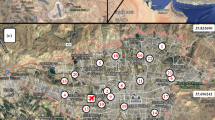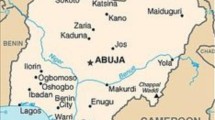Abstract
In this study, variations of ambient ozone level are thoroughly analysed according to the monitored data in a mixed residential, commercial and industrial city, Tehran, based on considering the meteorological factors. Ozone as a pollutant shows typical annual, weekly and diurnal cycles. This analysis has shown that the ozone level concentrations were below the WHO guidelines in Tehran during 2000–2003. The relation between ozone level at two different stations (Aghdasieh and Fatemi) is found (r = 0.51). The ozone level response to meteorological parameters is investigated. The results suggest that the ozone level is affected (positively or negatively) by meteorological conditions, e.g. relative humidity, solar radiation, air temperature, wind speed and wind direction.
Similar content being viewed by others
References
Alloway, B. J., & Ayres, D. C. (1993). Chemical principles of environmental pollution. London: Blackie.
Bloomfield, P., Royle, J. A., Steiberg, L. J., & Yang, Q. (1996). Accounting for meteorological effects in measuring urban ozone levels and trends. Atmospheric Environment, 30, 3067–3077. doi:10.1016/1352-2310(95)00347-9.
Emberson, L. D., Ashmore, M. R., Murray, F., Kuylenstierna, J. C. I., Percy, K. E., Izuta, T., et al. (2001). Impacts of air pollutants on vegetation in developing countries. Water, Air, and Soil Pollution, 130, 107–118. doi:10.1023/A:1012251503358.
EPA (1999). Guideline for developing an ozone forecasting program. Environmental Protection Agency, EPA-454/R-99-009.
Heidorn, K. C., & Yap, D. (1986). A synoptic climatology for surface ozone concentrations in Southern Ontario, 1976–1981. Atmospheric Environment, 20, 695–703. doi:10.1016/0004-6981(86)90184-8.
Lee, D. S., Holland, M. R., & Fella, N. (1996). The potential impact of ozone on materials in the UK. Atmospheric Environment, 30(7), 1053–1065. doi:10.1016/1352-2310(95)00407-6.
Lippman, M. (1989). Health effects of ozone: A critical review. Journal of the Air & Waste Management Association, 39, 672–695.
Lyons, T. J., & Scott, W. D. (1990). Principles of air pollution meteorology. London: Belhaven.
Massey, S. W. (1999). The effects of ozone and NOx on the deterioration of calcareous stone. The Science of the Total Environment, 227(2–3), 109–121. doi:10.1016/S0048-9697(98)00409-4.
Mayer, H., & Schmidt, J. (1993). Analyse der ozonkonzentrationen an sonn-und werktagen. Res. Rep., Meteorol. Inst. Univ. Freiburg.
Maynard, E. S. (1984). Review of the attributes and performance of 10 rural diffusion models. American Meteorological Society, 65(6), 554–558. doi:10.1175/1520-0477(1984)065<0554:ROTAAP>2.0.CO;2.
Wang, X., Lu, W., Wang, W., & Leung, A. Y. T. (2003). A study of ozone variation trend within area of affecting human health in Hong Kong. Chemosphere, 53, 1405–1410. doi:10.1016/S0045-6535(03)00476-4.
Author information
Authors and Affiliations
Corresponding author
Rights and permissions
About this article
Cite this article
Hosseinibalam, F., Hassanzadeh, S. & Alizadeh, R. Analysis and assessment of ground-level ozone measured at two stations in Tehran. Environ Monit Assess 165, 275–281 (2010). https://doi.org/10.1007/s10661-009-0944-3
Received:
Accepted:
Published:
Issue Date:
DOI: https://doi.org/10.1007/s10661-009-0944-3




